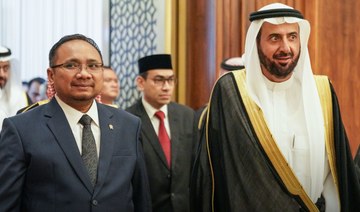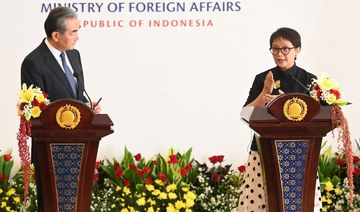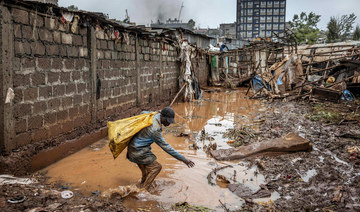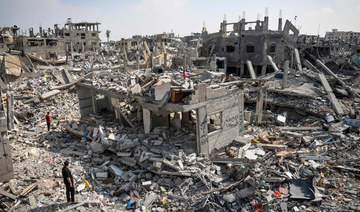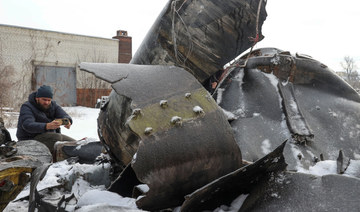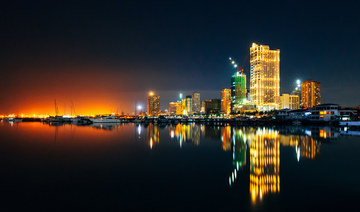BANGASSOU, Central African Republic: Bullet-riddled roofs line the “boulevard of death” in Central African Republic’s southeastern town of Bangassou, where almost everyone who enters is seen as an enemy.
The city, spared sectarian bloodshed until May, now has more than 2,000 Muslim residents forced to take refuge at the local cathedral after attacks by the mostly Christian anti-Balaka militia.
More than 300 people have been killed and 100,000 displaced since May as violence that began in 2013 moves into the impoverished country’s central and southeastern regions, prompting warnings of a national conflict roaring back to life.
In Bangassou alone, more than 150 people have died in fighting between militias and UN peacekeeping forces.
“We were driven out by force. We have lost our parents, our homes and all of our belongings,” said Djamal Haddine Mahamat-Salle, secretary-general of the organization representing the town’s displaced Muslims. “It’s been two-and-a-half months since we’ve been here, blocked without the ability to even go beyond 100 meters.”
Many said their departure from the cathedral could mean death.
“The anti-Balaka are everywhere. And as soon as you risk leaving, they will demand ransom,” said Zarah Mahamat. She said she tried to go to the market one day to buy vegetables for her children, who no longer have even rice to eat, and was stopped.
“I had to contact my parents in Bangui and they sent me the money to pay the ransom,” she said, still wearing the same clothes she had when she fled in May.
Another resident, Jean-Claude Gbienza, blamed the UN peacekeeping mission for provoking some of the violence. He said the forces arrived in May and started shooting, causing the local defense groups that are also part of the anti-Balaka to retaliate by burning homes and fighting.
Yvette Siolo said her hand was pierced by a bullet when the UN forces came in shooting. She said the rest of her family has fled to neighboring Congo, on the other side of the river.
On a visit to Bangassou this week, UN humanitarian chief Stephen O’Brien insisted that the UN is there to help, and he warned of the growing violence.
“We see the Muslim community who became the victims of attacks and this is an alarming situation. This cycle of violence must stop,” he said, calling for more support from the international community.
“If we do not act now and keep the faith, we will see increasing need and even greater vulnerability of already weakened people,” O’Brien said Tuesday.
The humanitarian crisis in Central African Republic, requiring some $497 million, is only 24 percent funded, the UN says. The world body says nearly 2.4 million people are in need of aid to survive.
During O’Brien’s visit, children who have not been to school for months held up signs that read “No to this open prison” and “I have a right to life and education.”
Central African Republic has faced fighting since 2013, when predominantly Muslim Seleka rebels seized power in the capital, Bangui. Anti-Balaka militias, mostly Christians, fought back, resulting in thousands of people killed and hundreds of thousands displaced.
Attempts at peace deals, the latest signed in June by more than a dozen armed groups, have failed.
The head of the UN peacekeeping force of 12,000 troops has acknowledged that the mission is not enough to protect civilians around the country.
The UN refugee agency says more than 60,000 people have fled into remote northern Congo since May, the majority women and children, with some sleeping in the open and “desperately” in need of food.
Deadly Central Africa violence returns
Deadly Central Africa violence returns

Saudi tourism launches first travel show in Indonesia

- Over 1.5 million Indonesians visited Saudi Arabia in 2023
- Saudi Tourism Authority exhibit in Jakarta runs until May 5
JAKARTA: The Saudi Tourism Authority launched on Wednesday its first show exhibition in Indonesia to introduce the Kingdom’s cultural and adventure destinations to visitors from the world’s largest Muslim-majority country.
The tourism sector has been booming under Vision 2030, as the Kingdom positions itself as a dynamic, diverse, year-round tourism destination and market that will contribute 10 percent to the gross domestic product by 2030.
Welcomed with dates and qahwa — traditional Arabic coffee — Indonesians flocked the STA exhibition inaugurated by Saudi Hajj and Umrah Minister Tawfiq Al-Rabiah and Alhasan Aldabbagh, STA president for Asia-Pacific markets, at the Kota Kasablanka Mall in South Jakarta.
“Saudi and Indonesia are good countries that have enjoyed social and economic ties for many, many years, and we have been receiving and welcoming many Indonesian travelers who are going for Umrah and Hajj,” Aldabbagh told reporters.
“We want to attract even more Indonesians, not just to do Umrah but to explore other places … Indonesia is a special market for us because of this strong relationship.”
More than 1.5 million Indonesians visited the Kingdom in 2023, but as most of them traveled for Umrah and focused on pilgrimage sites, Saudi authorities are hoping that they will begin to also explore the country’s rich history and heritage.
Aldabbagh was expecting about 10,000 visitors daily at the Jakarta exhibition, which will run until May 5.
“We want people to learn about all the attractions that we have in Saudi … to come with their families and enjoy and discover,” he said, giving as examples Jeddah and AlUla.

A historical city on the eastern shore of the Red Sea, Jeddah from the 7th century has been a major port for Indian Ocean trade routes and also the gateway for Muslim pilgrims to Makkah.
Featured on the UNESCO World Heritage List, Jeddah has a distinctive architectural tradition, with influences from along the ancient trade routes.
AlUla, another UNESCO site, is an ancient desert oasis and one of the most significant cultural cradles in the Arabian Peninsula.
The ancient kingdoms flourished in the AlUla Valley between 800 and 100 B.C. and were followed by Hegra — Saudi Arabia’s first location registered on the World Heritage List — was a major city of the Nabataean civilization whose capital, Petra, was located in present-day Jordan.
The Saudi travel show in Jakarta has already drawn interest from prospective visitors, who said they are intrigued by the variety of destinations the Kingdom had to offer.
“This is good for us to gain more information because we’ve never had this before, this is rare. Usually, we’ll get information from travel agencies, but this is coming straight from the Saudi authorities,” said Yudi Prasetyo, a Jakarta resident.
Another visitor, Linda Wardani, was curious to explore the Kingdom’s ancient sites, which she has so far known only from social media channels.
“We are curious to see AlUla looking so wonderful,” she said. “We are even more curious about other destinations in Saudi Arabia because when it comes to Umrah, the destinations are commonly known, but aside from that, we’re seeing the growth of Saudi Arabia and there are other tourist sites to see.”
Halid Umar Bakadam, CEO of Dream Tour travel agency, has also observed a growing interest beyond Umrah. His company now offers extended tours, where visitors can go and see other destinations in the Kingdom.
“They are welcoming more tourists,” he said. “For the new destinations, there are quite many people showing interest.”
Kenya flood toll rises to 179 as homes and roads are destroyed

- The death toll in Kenya exceeds that from flooding triggered by the El Nino weather phenomenon late last year
- Last year’s rains followed the worst drought in large parts of East Africa in decades
NAIROBI: Floods and landslides across Kenya have killed 179 people since March, with hundreds of thousands forced to leave their homes, the government said on Wednesday, as dozens more were killed in neighboring Tanzania and Burundi.
Torrential rain and floods have destroyed homes, roads, bridges and other infrastructure across the region. The death toll in Kenya exceeds that from flooding triggered by the El Nino weather phenomenon late last year.
Last year’s rains followed the worst drought in large parts of East Africa in decades.
In Kitengela, 33 km (20 miles) from Nairobi, Kenya Red Cross workers were helping to rescue residents whose homes were marooned by flood waters.
They were also trying to rescue tourists trapped at camps in Narok, 215 km from Nairobi, the Kenya Red Cross said on X.
Nairobi’s highways authority said it had closed a section of a highway leading to the city and at least three other roads across the country due to flooding and debris.
The disaster prompted Pope Francis to speak out in sympathy with Kenyans during a general audience on Wednesday at the Vatican.
“I ... wish to express to the people of Kenya my spiritual closeness at this time as severe flooding has tragically taken the lives of many of our brothers and sisters, injured others and caused widespread destruction,” he said.
More war debris in Gaza than Ukraine: UN

- UNMAS estimated the amount of debris in Gaza at 37 million tons in mid-April or 300 kilogrammes per square meter
- “Gaza has more rubble than Ukraine, and to put that in perspective, the Ukrainian front line is nearly 1,000 kilometers long, and Gaza is 40 km long,” said UNMAS’s head Mungo Birch
GENEVA: The Gaza Strip is filled with more war debris and rubble than Ukraine, the head of UN demining operations for the narrow Palestinian territory said Wednesday.
And the danger for clearance work is restricted not just to unexploded ordnance but includes possible exposure to toxic substances such as asbestos.
The United Nations Mine Action Service (UNMAS) estimated the amount of debris in Gaza at 37 million tons in mid-April, or 300 kilogrammes per square meter.
“Gaza has more rubble than Ukraine, and to put that in perspective, the Ukrainian front line is 600 miles (nearly 1,000 kilometers) long, and Gaza is 25 miles (40 km) long,” said Mungo Birch, head of the UNMAS program in the Palestinian territories.
But the sheer volume of rubble is not the only problem, said UNMAS.
“This rubble is likely heavily contaminated with UXO (unexploded ordnance), but its clearance will be further complicated by other hazards in the rubble,” Birch told journalists.
“There’s estimated to be over 800,000 tons of asbestos, for instance, alone in the Gaza rubble.” The cancer-causing mineral used in construction requires special precautions when handling.
Birch said he hoped UNMAS, which works to mitigate the threats posed by all types of explosive ordnance, would become the coordination body for mine action in Gaza.
It has secured $5 million of funding but needs a further $40 million to continue its work in Gaza over the next 12 months.
However, “the sector as a whole will need hundreds of millions of US dollars over multiple years in order to make Gaza safe again for the population,” Birch added.
The Gaza war started after Hamas’s October 7 attack on southern Israel, which resulted in the deaths of 1,170 people, mostly civilians, according to an AFP tally of Israeli official figures.
Israel’s retaliatory offensive has killed at least 34,568 people in Gaza, mostly women and children, according to the health ministry in the Hamas-run territory.
Philippines bets on wellness, medical tourism to attract Middle Eastern visitors

- Philippines wants position as a leading halal tourism destination
- Nation aims to welcome 7.7m international visitors in 2024
MANILA: The Philippine tourism sector is shifting to promote the country as a medical and wellness destination, expanding beyond its recreational profile to attract more visitors from the Middle East.
More than 2 million international travelers visited the Philippines since the beginning of the year, with receipts between January and April reaching $2.7 billion. This data, the Department of Tourism said last week, was a 120 percent recovery rate from the same period in 2019 — before COVID-19 lockdowns brought the industry to a standstill.
The department’s data also showed a 10 percent increase in visitors arriving from Gulf countries, especially Saudi Arabia and the UAE, which are among the Philippine government’s key emerging-market targets.
To further boost their arrivals and make the country a more attractive destination, tourism stakeholders are shifting their strategy to focus more on the wellness sector, Philippine Tour Operators Association President Arjun Shroff told Arab News.
“This strategic shift aims to position the Philippines as an emerging medical and wellness destination in Asia, expanding beyond its traditional recreational tourism offerings like beaches and diving spots,” he said.
Efforts have also been undertaken to expand the footprint of halal services and goods.
The predominantly Catholic Philippines — where Muslims constitute about 10 percent of the nearly 120 million population — plans to raise 230 billion pesos ($4 billion) in investments and generate around 120,000 jobs by expanding its domestic halal industry by 2028.
The cross-sector efforts include tourism as well, with the Philippines trying to position itself as a leading halal tourism destination.
“We have recently implemented a range of strategic initiatives to enhance our appeal to visitors from the Middle East. Central to our approach is a commitment to inclusivity, ensuring that all tourists feel welcome and safe,” Shroff said.
“In line with this commitment, we have actively promoted halal establishments to cater to the dietary preferences of Middle Eastern travelers. By offering a variety of halal dining options, we aim to provide a seamless and enjoyable culinary experience.”
Filipinos have been exposed to the Middle East, especially Gulf countries, which are home to some 2 million Philippine expats. They understand cultural differences and many also know Arabic.
The tourism sector has lately been tapping into Arabic-speaking talent to help facilitate tours for Middle Eastern travelers.
“We have invested in bilingual tour guides proficient in Arabic ... These guides play a vital role in facilitating communication, providing valuable insights, and enhancing the overall experience for our Middle Eastern guests,” Shroff said.
“Philippine travel and tourism agencies strategically target the Middle East market ... (it) holds great potential for the Philippines.”
In 2024, the Philippines is targeting to welcome 7.7 million international visitors, nearly its pre-pandemic record-breaking achievement in 2019 which ended with 8.26 million inbound arrivals.
Resurgent terror groups in Afghanistan will strike West, warns resistance leader

- Exiled head of National Resistance Front says Al-Qaeda, Daesh presence growing in country
- Taliban emboldened by Western commitment to Ukraine, focus on Middle East
London: Terrorist groups in Afghanistan are regrouping in the wake of the Western evacuation from the country and will strike on US and European soil, the leader of an anti-Taliban movement has warned.
The exiled leader of Afghanistan’s National Resistance Front, Ahmad Massoud, said a terror attack in the US or Europe is “not about a matter of if, it’s a matter of when,” The Independent reported.
Massoud said circumstances in the country and the wider region resemble the pre-9/11 landscape, with terror training camps opening across Afghanistan.
Ali Maisam Naziry, the NRF’s head of foreign relations, said of the resurgent groups: “The attacks in Russia, Iran and Brussels, and the neutralised attack in Germany, are examples of how fast they are moving to threaten global security.”
He added that since the Taliban’s return to power in 2021, Afghanistan has witnessed a “massive influx” of foreign terrorist fighters who belong to the more than 20 militant networks operating in the country, including Al-Qaeda, Daesh-Khorasan and the Haqqani Network.
Massoud warned that the West’s commitment to Ukraine and Israel is serving as a distraction, emboldening the Taliban in the process.
Afghanistan is “no longer a priority” for the Biden administration in the US, he told The Independent last year.
Nathan Sales, a former US ambassador-at-large and coordinator for counterterrorism, said last year: “The continued partnership between the Taliban and Al-Qaeda is perhaps best seen in the fact that after the US withdrawal, Al-Qaeda leader Ayman Al-Zawahiri resurfaced in Afghanistan, living in a safe house associated with the Haqqani Network, a Taliban faction that maintains close ties to Al-Qaeda and is itself a US-designated Foreign Terrorist Organization.
“The key takeaway is that the Taliban felt emboldened to welcome Al-Qaeda’s leader back to Kabul, and Al-Qaeda’s leader felt it was safe enough there to accept the offer.”


